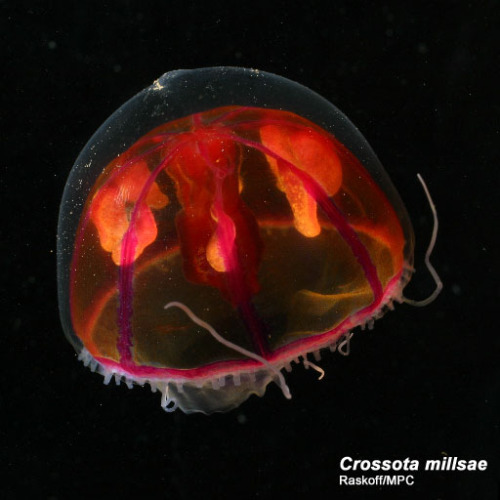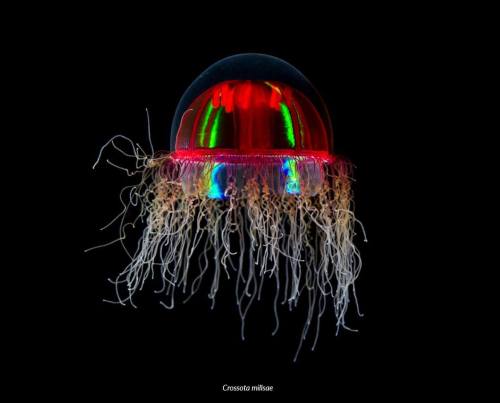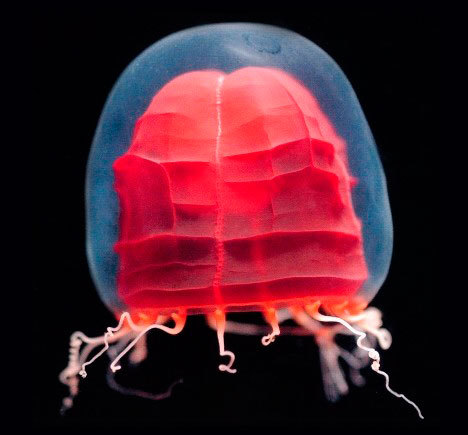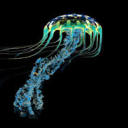Vampire Squid

Vampire Squid
Vampyroteuthis infernalis
Even though the Vampire Squid is named after a notorious monster, this gentle creature does not live up to its name. It is only a foot long and occupies depths between 650m to 1500m in the deep ocean. Unlike other squids, it has reduced musculature and collects particles in the water column. However, it is capable of huge bursts of speeds. It uses bioluminescence to confuse both predators.
Photo credit: https://ocean.si.edu/ocean-life/invertebrates/vampire-squid-hell
More Posts from Bioluminescentoceangoddess and Others


Pigbutt worm
Chaetopterus pugaporcinus
The Pigbutt worm or the flying buttocks of the sea is spotted floating between 965 m to 1300 m in the deep ocean. It is actually a polychaete (polly-keet) worm species that burrows in the ground as an adult, and floats around the ocean as a baby. The worm feeds itself : by creating a balloon of mucus; collecting particles on the mucus; and then consuming the particles. It is the rarest and thickest worm in the deep ocean, for only ten have been spotted.
Photocredit: https://roaring.earth/pigbutt-worm/

Threadfin Snailfish
Careproctus longifilis
The Threadfin Snailfish resembles a prehistoric tadpole that is ghostly white. The holes in its face are large sensory pores that help them detect changes in the ocean. It is often found at depths between 1900 to 2997 meters.
Photo credit: https://www.timeout.com/singapore/museums/creatures-of-the-deep


Glowing sucker octopus
Stauroteuthis syrtensis
The Glowing Sucker Octopus can be found at 2500 m in the deep ocean. This unique creature has two fins that look similar to elephant ears. They move elegantly through the water by moving these fins and contracting their mantle. Evidence of this creature has only been spotted in the Atlantic Ocean.
Photo credit: https://octolab.tv/species/glowing-sucker-octopus/
https://ferrebeekeeper.wordpress.com/2011/03/14/glowing-sucker-octopus/


Wolftrap Angler
Thaumatichthys binghami
The Wolftrap Angler is slightly different from many other species of anglers. It has its bioluminescent lure located inside of its mouth instead of connected to its body. Even though it is intimidating up close, it is only nine centimeters in size. It is found in the deep ocean at 2432m.
Photo credit
https://en.wikipedia.org/wiki/Thaumatichthys_binghami
https://igniteyourcuriosity.wordpress.com/2016/10/22/anglerfish/


Silky Medusa
Colobonema sericeum
The Silky Medusa is a gentle and reserved jellyfish; it has white-tipped tentacles that have the ability to detach from its body and bioluminescence when attacked by predators. It can be found drifting between 500 m to 1500 m. Furthermore, it consumes small crustaceans.
Photo credit: https://twitter.com/mbari_news/status/949736123760340994
https://www.montereybayaquarium.org/animals/animals-a-to-z/midwater-jelly


Spookfish
Winteria telescopa
The Spookfish’s eyes act as a telescope and are designed to maximize light in the deep ocean. Its eyes contain rod cells that help distinguish between ambient light and bioluminescent light. This adaptation helps avoid predators and catch prey.
Picture Credit: https://www.natureplprints.com/deep-sea/deep-sea-fish-winteria-telescopa-15230734.html

Black- eyed squid
Gonatus onyx
The Black-eyed Squid is roughly over one foot (35 am) and is found at depths as deep as 2500m. The female Black-eyed Squid works fiercely to protect her babies, by carrying around a patch of egg for six to nine months. When the eggs hatch, 2000 to 3000 babies are released into the ocean. However, this makes her vulnerable to predators.
Photocredit: http://tolweb.org/Gonatus+onyx/19769


Psychedelic Medusa
Crossota millsae
The Psychedelic Medusa is a deep-sea hydrozoan that is abundant in the North Pacific. The mini-jelly is found at depths between 1000m to 3800m, and are often observed drifting near the ocean floor. It also has an eccentric reproduction behavior uncommon in cnidarians. The females display viviparity, and carry the babies in her bell until they are ready to hatch.
Photo credit: http://www.arcodiv.org/watercolumn/cnidarian/Crossota_millsae.html
https://twitter.com/spothvegr/status/1030177493075079169


Piglet Squid
Helicocranchia pfefferi
The Piglet Squid is a very small and delicate, transparent squid. It is found at depths between 400 to 1000 m. It has an unique siphon that is used for jet propulsion and it resembles a pig muzzle. The young piglet squids tend to live close to the surface, and steadily migrates downward as they grow. This behavior is called ontogenetic migration.
Photo credit: http://photo.cctv.com/2019/07/23/PHOAKMEBh8xJRaHXEUIGx8kE190723.xml
https://www.ourbreathingplanet.com/banded-piglet-squid/


Red Paper Lantern Medusa
Pandea rubra
The Red Paper Lantern resembles a floating, Japanese paper lantern in the deep sea. It has the ability to crumple and wrinkle its bright, red bell, and it is located at depths between 550m to 1200m. It has also been nicknamed the “origami jelly.”
Photo credit: https://commons.wikimedia.org/wiki/Category:Pandea_rubra
http://www.thegorgeousdaily.com/pandea-rubra/
-
 mycellpics liked this · 1 year ago
mycellpics liked this · 1 year ago -
 mawsteeth liked this · 2 years ago
mawsteeth liked this · 2 years ago -
 unknowinglysenescent reblogged this · 2 years ago
unknowinglysenescent reblogged this · 2 years ago -
 unknowinglysenescent liked this · 2 years ago
unknowinglysenescent liked this · 2 years ago -
 fruitbatsblog reblogged this · 3 years ago
fruitbatsblog reblogged this · 3 years ago -
 jerrielzapata liked this · 3 years ago
jerrielzapata liked this · 3 years ago -
 rainwrapped reblogged this · 3 years ago
rainwrapped reblogged this · 3 years ago -
 despair-with-walnuts liked this · 3 years ago
despair-with-walnuts liked this · 3 years ago -
 windyboysworld liked this · 3 years ago
windyboysworld liked this · 3 years ago -
 warinababylon reblogged this · 3 years ago
warinababylon reblogged this · 3 years ago -
 charlieacrid liked this · 3 years ago
charlieacrid liked this · 3 years ago -
 miresgaleth liked this · 3 years ago
miresgaleth liked this · 3 years ago -
 creaturedeityendless liked this · 3 years ago
creaturedeityendless liked this · 3 years ago -
 sweet-sea-monster reblogged this · 3 years ago
sweet-sea-monster reblogged this · 3 years ago -
 edgeworst liked this · 3 years ago
edgeworst liked this · 3 years ago -
 salvagethevixin liked this · 4 years ago
salvagethevixin liked this · 4 years ago -
 voivsu reblogged this · 4 years ago
voivsu reblogged this · 4 years ago -
 gratifymeimmediately liked this · 4 years ago
gratifymeimmediately liked this · 4 years ago -
 pondscum reblogged this · 4 years ago
pondscum reblogged this · 4 years ago -
 mixhaellcruz liked this · 4 years ago
mixhaellcruz liked this · 4 years ago -
 opossum-mossum liked this · 4 years ago
opossum-mossum liked this · 4 years ago -
 that-lesbian-phenotype liked this · 4 years ago
that-lesbian-phenotype liked this · 4 years ago -
 disableddeinosaur liked this · 4 years ago
disableddeinosaur liked this · 4 years ago -
 drhoz liked this · 4 years ago
drhoz liked this · 4 years ago -
 cinnamonteo reblogged this · 4 years ago
cinnamonteo reblogged this · 4 years ago -
 notwiselybuttoowell liked this · 4 years ago
notwiselybuttoowell liked this · 4 years ago -
 fishwantmewomenfearme reblogged this · 4 years ago
fishwantmewomenfearme reblogged this · 4 years ago -
 fishwantmewomenfearme liked this · 4 years ago
fishwantmewomenfearme liked this · 4 years ago -
 sidhehound reblogged this · 4 years ago
sidhehound reblogged this · 4 years ago -
 peter-platin liked this · 4 years ago
peter-platin liked this · 4 years ago -
 trinns liked this · 4 years ago
trinns liked this · 4 years ago -
 relatablepicturesoftinywhalesfin liked this · 4 years ago
relatablepicturesoftinywhalesfin liked this · 4 years ago -
 madnessmethodx reblogged this · 4 years ago
madnessmethodx reblogged this · 4 years ago -
 cadaverchan liked this · 4 years ago
cadaverchan liked this · 4 years ago -
 fursskinshells reblogged this · 4 years ago
fursskinshells reblogged this · 4 years ago -
 aeternumquaerere reblogged this · 4 years ago
aeternumquaerere reblogged this · 4 years ago -
 aeternumquaerere liked this · 4 years ago
aeternumquaerere liked this · 4 years ago -
 velociraptrix reblogged this · 4 years ago
velociraptrix reblogged this · 4 years ago -
 velociraptrix liked this · 4 years ago
velociraptrix liked this · 4 years ago -
 squid-ichorous reblogged this · 4 years ago
squid-ichorous reblogged this · 4 years ago -
 squid-ichorous liked this · 4 years ago
squid-ichorous liked this · 4 years ago -
 swords0827 liked this · 4 years ago
swords0827 liked this · 4 years ago -
 starlightbrethren liked this · 4 years ago
starlightbrethren liked this · 4 years ago -
 mloramagica reblogged this · 4 years ago
mloramagica reblogged this · 4 years ago -
 askmeabout-my-bxgcxck liked this · 4 years ago
askmeabout-my-bxgcxck liked this · 4 years ago

Bioluminescence is a chemical reaction that produces light. Many deep sea animals use bioluminescence. This blog is dedicated to educating the public about the amazing creatures that thrive in the deep sea.
57 posts